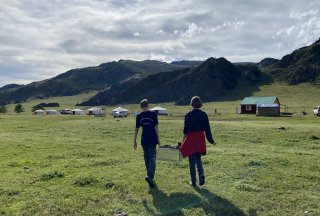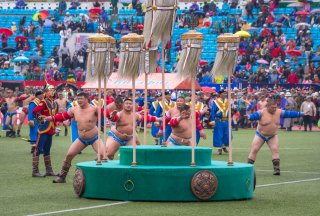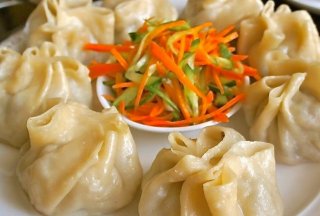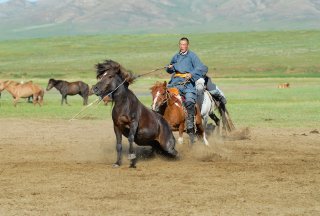1. Mongolian and Central Asian’s History
Chinngis Khan founded the largest imperium in square metres in the world ever. Mongolia’s tumultuous warrior is widely known for his fearless urge to conquer the world. Whether you like it or not, he has been a significant factor in the world’s history and Central Asia specifically. To get a better understanding of Mongolia and its nation, it was inevitable for me to dive into the history of Chinggis Khan’s and the Mongolian empire that stretched from Far East Asia to Venice.
Nowadays, Chinggis Khan is everyday business: hotels are named after the imperialist, cigars, vodka, bars, beer and more! Close to UB Chinggis has his very own 60 metres high giant silver statue. The statue is impressively huge. The whole entourage, the visitor centre and the statue with all its grandeur is so opposite of what we experienced while travelling in the country. And this is exactly the bizarreness that makes Mongolia so unique.
2. Mongolian Nomads
The Mongolian authentic way of life is the nomadic way of life. Ulaanbaatar is home to half of the Mongolian population, the Mongolian land is home to the other half. Although many city inhabitants still have family in the countryside, their daily lives are contrasting. Nomadic life is not easy. We visited Mongolia in October and it was already incredibly cold. For me at least, coming from the Netherlands. Surviving Mongolian winters with temperatures of -50 ℃ is serious business. A growing number of Mongolian nomads decide to leave their nomadic lifestyle, reduce their number of livestock and move to the city.
Staying at nomad families during my trip in Mongolia was an uncommon and memorable experience. I am not talking tourist camps with showers and luxurious yurts. I refer to families opening their yurt door for you, no knocking required. It felt a little uncomfortable at first. Nevertheless, it is common that the family sleeps in their extra (most of them have at least one extra) yurt and let visitors sleep in theirs. My best nights of sleep where in a yurt on a thin mattress. The way of life is so far away of what we – in the Western world – are used to. It makes a trip to Mongolia a true nomadic adventure.
3. Mongolian Animals
I love animals and Mongolians love their animals. Not in the same way though but it didn’t matter. As a non-meat-eater it’s not the most convenient destination to travel. If you love animals and accept that livestock is the only way of survival for nomads, it changes your perspective. The deep unfathomable green – in October white and yellow – fields are where the Mongolian animals graze. Herds of sheep, horses, yaks, cow, thousands of goats. Vultures eating carcases, dogs protecting the yurt, camels waiting for their tourist ride. Wolves killing sheep to fill their belly. Mongolian land is home to millions of animals.
4. Space and Serenity
One of the aspects of travelling I love is the experience of being the only one there. Serenity, no noise, no other travellers. Just nothing. It freaks other people out, it relaxes me completely. I sensed this calmness in Mongolia, where we drove for hours without seeing anyone. The population density is the lowest in the world: 1,9 inhabitants live on 1 km2. Yes, that’s right, just 1,9. You can imagine that in a country of 1.566.000 km², there is a lot of space. The middle of nowhere is literally everywhere in Mongolia.
5. Nature
Unlimited wilderness. The diversity in nature is unique. Mongolia is known for its endless valleys and grasslands but did you know Mongolia has volcanos, awesome rock formations and many stunning lakes? And even a desert called ‘Gobi’. Gobi means ‘huge and dry’ and the desert is the number 4 largest desert is the world. Not bad right? And it gets better: you can see prehistoric dinosaur eggs. Mongolian landscape changes in minutes or doesn’t change for hours. One thing is for sure: Mongolian nature is magical.
6. Roads in Mongolia: The Worst Roads in the World
Part of a Mongolian travel adventure is driving in a 4WD and conquer the worst roads in the world. Although it is not a high priority of the current government, it is expected that sooner or later road quality will improve and more roads will be built. Sitting in the back seat of a car driving on the bumpiest roads ever, I often wondered ‘why are these roads this bad’? Which our guide replied with: ‘This is Mongolia’. It was part of the adventure. We did many river crossings and I loved it – apart from that time where it snowed and we slipped back into the water. Our Mongolian road trip was awesome, driving in no man’s land is fantastic. Yet another reason to go now and experience a Mongolian road trip the way you should!
7. Contradictions
The habitat outside of Ulaanbaatar is far from what city life is about. Where a motorbike or horse is your transport, where a yurt is your home and where thousands of livestock are your pride. No electricity, no running water, nothing that we would define as luxury. But luxury is different for everyone in the world. For you, it could be 5* hotel, for someone else it could be freedom. For Mongolian nomads is could be their 3.000 goats. In the capital are many shops, coffee cafes, most of the Mongolians have smart-phones. The city is covered in smog, traffic jams are substantial and skyscrapers embellish the horizon. It may surprise you but I have seen more posh SUV’s in Ulaanbaatar then I see on an average day in Amsterdam. Mongolia is a country of contradictions. Contradictions prevail in many areas and made my trip a fascinating experience.
8. Lack of Tourism
Although most travellers opt for Russia or China, tourism will take over somehow someday in Mongolia. It’s just a matter of time. Inland there are few facilities for travellers, at least when we were there at the end of October. I read that until the end of September it is easier to travel and there are more facilities available. It surprised me though that in the region of Ulaanbaatar tourism is exploding already. Tourist camps in Terelj and near the Chinggis Khan statue come fast and furious out of nowhere. While travelling by car in Central Mongolia at the end October, I have seen only one small group of other travellers on the first day of our trip. And a few at Erdenezuu Monastery. That won’t happen barely anywhere else in Asia I guess.
Quokka.travel-Personal bloger 2017



















